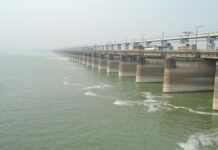It started with a bang at 3 a.m. Monday as the residents of Derna were sleeping. One dam burst, then a second, sending a huge wave of water gushing down through the mountains towards the coastal Libyan city, killing thousands as entire neighborhoods were swept into the sea.
At least 5,000 people in Libya have been killed by this week’s floods, Doctors Without Borders (Médecins sans frontières) said in a statement Thursday, revising an earlier estimate.
The eastern Libyan city of Derna, the epicenter of the disaster, had a population of around 100,000 before the tragedy. Authorities say that at least 10,000 remain missing. CNN could not independently verify the figures.
Buildings, homes and infrastructure were “wiped out” when a 7-meter (23-foot) wave hit the city, according to the International Committee of the Red Cross (ICRC), which said Thursday that dead bodies were now washing back up on shore.
But with thousands killed and many more still missing, there are questions as to why the storm that also hit Greece and other countries caused so much more devastation in Libya.
Experts say that apart from the strong storm itself, Libya’s catastrophe was greatly exacerbated by a lethal confluence of factors including aging, crumbling infrastructure, inadequate warnings and the impacts of the accelerating climate crisis.
A ferocious storm
The extreme rainfall that hit Libya on Sunday was brought by a system called Storm Daniel.
After sweeping Greece, Turkey and Bulgaria, with severe flooding that killed more than 20 people, it formed into a “medicane” over the Mediterranean – a relatively rare type of storm with similar characteristics to hurricanes and typhoons.
The medicane strengthened as it crossed the unusually warm waters of the Mediterranean before dumping torrential rain on Libya on Sunday.
It brought more than 16 inches (414 mm) of rainfall in 24 hours to Al-Bayda, a city west of Derna, a new record.
A history of flooding
Derna is prone to flooding, and its dam reservoirs have caused at least five deadly floods since 1942, the latest of which was in 2011, according to a research paper published by Libya’s Sebha University last year.
The two dams that burst on Monday were built around half a century ago, between 1973 and 1977, by a Yugoslav construction company. The Derna dam is 75 meters (246 feet) high with a storage capacity of 18 million cubic meters (4.76 billion gallons). The second dam, Mansour, is 45 meters (148 feet) high with a capacity of 1.5 million cubic meters (396 million gallons).
Those dams haven’t undergone maintenance since 2002, the city’s deputy mayor Ahmed Madroud told Al Jazeera.
But the problems with the dams were known. The Sebha University paper warned that the dams in Derna had a “high potential for flood risk” and that periodic maintenance is needed to avoid “catastrophic” flooding.
A lack of warnings
Better warnings could have avoided most of the casualties in Derna, the head of the United Nations’ World Meteorological Organization, Petteri Taalas, said.
“If there would have been a normally operating meteorological service, they would have issued the warnings and also the emergency management of this would have been able to carry out evacuations of the people and we would have avoided most of the human casualties,” Taalas told reporters at a news conference Thursday.
Talaas added that the political instability in the country has impeded WMO efforts to work with the Libyan government to improve these systems. Yet, even robust early warning systems are not a guarantee that all lives can be saved, said Cloke.
Dam failures can be very hard to forecast, and are fast and ferocious, she told CNN. “You have this monstrous volume of water just taking out the city entirely,” Cloke said. “It’s one of the worst types of floods that ever happens.”
While dams are usually designed to withstand relatively extreme events, it’s often not enough, said Cloke. “We should be preparing for unexpected events, and then you put climate change on top, and that ramps up these unexpected events.”
The risk climate-fueled extreme weather poses to infrastructure – not just dams, but everything from buildings to water supplies – is a global one. “We’re not ready for the extreme events coming towards us,” Cloke said. -CNN































